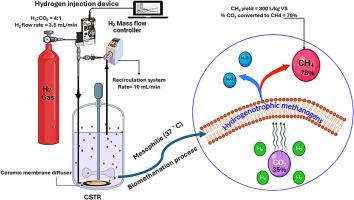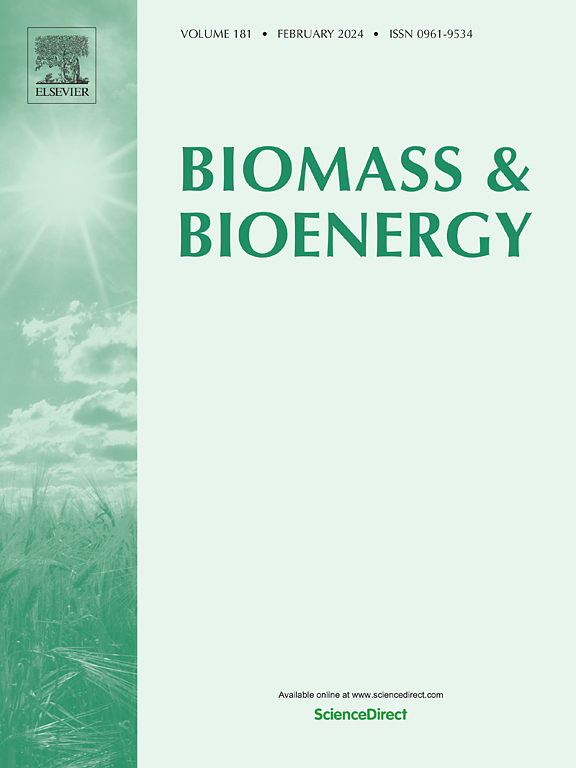Improving in-situ biomethanation of sewage sludge under mesophilic conditions: Performance and microbial community analysis
IF 5.8
2区 生物学
Q1 AGRICULTURAL ENGINEERING
引用次数: 0
Abstract
This research investigated the application of in-situ biological hydrogen methanation within a continuous stirred tank reactor (CSTR) system under mesophilic conditions, with sewage sludge used as the substrate. Two CSTRs with an effective capacity of 5 L were installed and loaded with inoculum sludge with a volatile solid (VS) concentration of 1.2–1.5 %. They were fed mixed waste sludge with an organic loading rate (OLR) of 1.5 g VS/L and an average sludge retention time (SRT) of 19 days under mesophilic conditions at 37 °C. One of the reactors operated as a control, while the other was injected with H2 through a microceramic membrane diffuser with a H2:CO2 ratio of 4:1. The results of this study revealed that the addition of H2 and the recirculation of residual hydrogen in biogas led to a substantial increase in the production of methane from 157 L/kg VS to 275 L/kg VS. Increasing the methane content in biogas from 52 % to 78 % yielded an impressive 42.8 % higher methane production rate. Metataxonomic analysis of the microbial community via high-throughput sequencing techniques revealed that the dominant acetoclastic and hydrogenotrophic methanogens were Methanosaeta and Methanoregula, respectively, with greater abundances of both groups in the experimental bioreactor. The dynamics of their activity in both bioreactors were analyzed via qPCR, and the functional genes encoding methyl-coenzyme M reductase (mcrA gene) and hydrogenase Ni-Fe presented comparable changes between RI and RII. By optimizing key operational parameters and closely examining the dynamics of the microbial community, this approach can contribute significantly to sustainable bioenergy solutions while minimizing environmental impact.

改进中温条件下的污水污泥原位生物甲烷化:性能和微生物群落分析
本研究调查了在中温条件下,以污水污泥为基质,在连续搅拌槽反应器(CSTR)系统中应用原位生物氢甲烷化的情况。安装了两个有效容量为 5 升的 CSTR,并装入了挥发性固体(VS)浓度为 1.2-1.5 % 的接种污泥。在 37 °C 的嗜中性条件下,它们向混合废污泥进料,有机负荷率(OLR)为 1.5 g VS/L,平均污泥停留时间(SRT)为 19 天。其中一个反应器作为对照,另一个反应器通过微陶瓷膜扩散器注入 H2,H2:CO2 的比例为 4:1。研究结果表明,在沼气中加入 H2 和残余氢再循环可使甲烷产量从 157 升/千克 VS 大幅增至 275 升/千克 VS。将沼气中的甲烷含量从 52% 提高到 78%,甲烷生产率大幅提高了 42.8%。通过高通量测序技术对微生物群落进行的元分类分析表明,最主要的嗜乙酰甲烷菌和嗜氢甲烷菌分别是 Methanosaeta 和 Methanoregula,在实验性生物反应器中这两类菌的数量都较多。通过 qPCR 分析了这两种生物反应器中甲烷菌的活性动态,发现编码甲基辅酶 M 还原酶(mcrA 基因)和氢化酶 Ni-Fe 的功能基因在 RI 和 RII 中的变化相当。通过优化关键操作参数和密切观察微生物群落的动态变化,这种方法可以为可持续生物能源解决方案做出重大贡献,同时最大限度地减少对环境的影响。
本文章由计算机程序翻译,如有差异,请以英文原文为准。
求助全文
约1分钟内获得全文
求助全文
来源期刊

Biomass & Bioenergy
工程技术-能源与燃料
CiteScore
11.50
自引率
3.30%
发文量
258
审稿时长
60 days
期刊介绍:
Biomass & Bioenergy is an international journal publishing original research papers and short communications, review articles and case studies on biological resources, chemical and biological processes, and biomass products for new renewable sources of energy and materials.
The scope of the journal extends to the environmental, management and economic aspects of biomass and bioenergy.
Key areas covered by the journal:
• Biomass: sources, energy crop production processes, genetic improvements, composition. Please note that research on these biomass subjects must be linked directly to bioenergy generation.
• Biological Residues: residues/rests from agricultural production, forestry and plantations (palm, sugar etc), processing industries, and municipal sources (MSW). Papers on the use of biomass residues through innovative processes/technological novelty and/or consideration of feedstock/system sustainability (or unsustainability) are welcomed. However waste treatment processes and pollution control or mitigation which are only tangentially related to bioenergy are not in the scope of the journal, as they are more suited to publications in the environmental arena. Papers that describe conventional waste streams (ie well described in existing literature) that do not empirically address ''new'' added value from the process are not suitable for submission to the journal.
• Bioenergy Processes: fermentations, thermochemical conversions, liquid and gaseous fuels, and petrochemical substitutes
• Bioenergy Utilization: direct combustion, gasification, electricity production, chemical processes, and by-product remediation
• Biomass and the Environment: carbon cycle, the net energy efficiency of bioenergy systems, assessment of sustainability, and biodiversity issues.
 求助内容:
求助内容: 应助结果提醒方式:
应助结果提醒方式:


